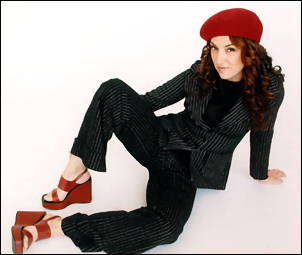
Gabriela Anders
Gabriela Anders was born into a family of musicians. The Argentinean native studied classical guitar and piano in Buenos Aires while listening closely to her father, jazz saxophonist Jorge Anders. “There were so many influences when I was growing up, and I wanted to do something with them all. My father’s concerts and studio work certainly affected me, as did the music of Brazil— it’s so harmonically rich and so interesting melodically. ” After high school, Anders decided to continue her studies in New York. After a short while, she started to do studio and club work. This work lead to two recording projects with top producer Sergio George under the name Beleza. Through Sergio, she had the opportunity to sing for Grover Washington, Jr., Marc Anthony, Celia Cruz & DLG.
Her ongoing exposure to music of various sensibilities and her innate ability to fuse styles and formats were abundantly revealed in a few demo tracks she made on the cheap. Shortly thereafter, the stunning beauty became one of the only artists ever signed to Warner Bros. from unsolicited material. Her first appearance on the Warner Bros. sampler JAZZ CHRISTMAS PARTY (1998) was followed by Gabriela’s 1999 debut, Wanting is brimming with vocal subtlety; although smooth, it is anything but simple (she wrote ten of the twelve tracks). Gabriela Anders continued a journey of musical excellence and introspection with her releases, Eclectica, a collection of brazilian, rhythm’n blues and jazz- influenced songs andLatina, an all spanish adventure.
The new Gabriela Anders CD, Bossa Beleza, blends her own immediately recognizable sound with that of her first musical love, classic Bossa Nova. Eleven soulful and intimate tracks, including the Brazilian standards “Dindi”, “Folhas Secas”, “One Note Samba” and “Agua de Beber”, as well as Gabriela’s take on the Rolling Stones’ “Satisfaction” and Earth, Wind and Fire’s “September,” plus three original songs, are all infused with the beautiful Bossa Nova sound so famously popularized in the US during the 60s by artists including Antonio Carlos Jobim, Frank Sinatra, Stan Getz and Astrud Gilberto. Gabriela is happy to have finally documented her own vision of a style that was so much a part of her own musical development, and that she continues to feel such an affinity for.















 The VOCAL SOUND OF JAZZ began airing on 89.5 FM (now WHRV-FM) on January 4th 1980. Originally a 30 minute program that aired on Friday evenings, the program expanded to it current 60 minute format and moved to Saturday evenings during the 90s. It was also aired over WUOM in Ann Arbor, Michigan for a five-year period in the late 1980s.
Produced and hosted by Jack Frieden since its premiere broadcast, the program has always attempted to spotlight both jazz vocal music’s post 1950s history, as well as the new singers and songs that will continue to play an increasingly prominent role in the music’s future. With the internet’s ability to attract and entertain jazz vocal fans globally, Jack looks forward to broadening the mission and reach of the “Vocal Sound of Jazz” in coming years.
Email Jack Frieden
Vocal Sound of Jazz LLC
1056 Downshire Chase
Virginia Beach, Va. 23452
Ph: 757 438 6785
The VOCAL SOUND OF JAZZ began airing on 89.5 FM (now WHRV-FM) on January 4th 1980. Originally a 30 minute program that aired on Friday evenings, the program expanded to it current 60 minute format and moved to Saturday evenings during the 90s. It was also aired over WUOM in Ann Arbor, Michigan for a five-year period in the late 1980s.
Produced and hosted by Jack Frieden since its premiere broadcast, the program has always attempted to spotlight both jazz vocal music’s post 1950s history, as well as the new singers and songs that will continue to play an increasingly prominent role in the music’s future. With the internet’s ability to attract and entertain jazz vocal fans globally, Jack looks forward to broadening the mission and reach of the “Vocal Sound of Jazz” in coming years.
Email Jack Frieden
Vocal Sound of Jazz LLC
1056 Downshire Chase
Virginia Beach, Va. 23452
Ph: 757 438 6785